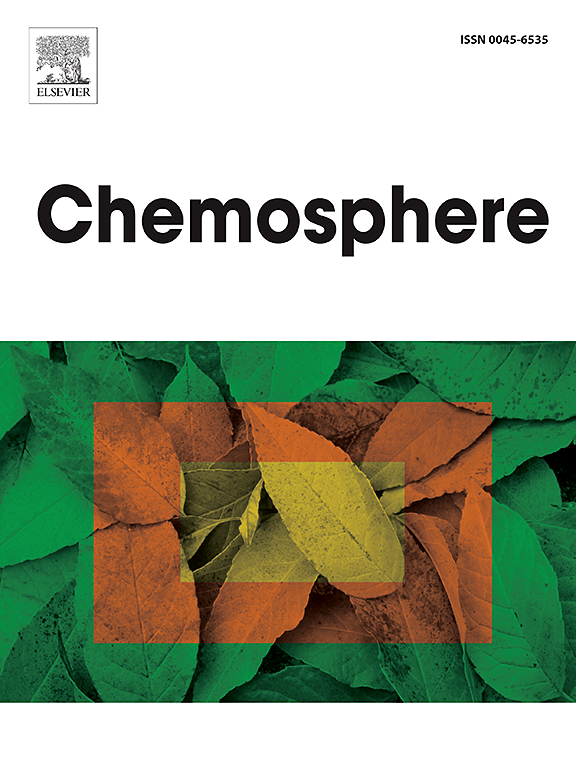追踪放射性标记聚苯乙烯微塑料在年轻大西洋扇贝(Placopecten magellanicus):生物积累,净化和生物能量影响评估
IF 8.1
2区 环境科学与生态学
Q1 ENVIRONMENTAL SCIENCES
引用次数: 0
摘要
塑料的大量生产和使用导致它们以各种形式释放到海洋生态系统中,这是一个主要的环境污染问题。降解和破碎过程将塑料分解成细颗粒,称为微塑料(MPs)和纳米塑料(NPs),其生物积累和对海洋生物的影响在很大程度上仍然未知。本研究研究了1.5±0.3 μm聚苯乙烯微粒(PS-MPs)的长期生物积累和净化动力学以及生物分布,并评估了它们对大西洋非生殖扇贝幼体能量储备的影响。在三个月的暴露期内使用了三种处理方法;用微藻和14c -PS (14C-PS-MPs)混合物喂养的生物,其浓度接近海洋环境中预期的水平;这些生物接受同样的处理,但没有放射性标记的PS-MPs,而对照生物只喂食微藻混合物。此后,在3个月的时间里,对扇贝的净化情况进行监测,扇贝只接受微藻。射线自显像数据显示,扇贝摄入的14C-PS-MPs集中在消化道中。肝胰腺(6300±4900 Bq•g−1ww)和肌肉(85±81 Bq•g−1ww)样品中的14C-PS-MPs水平显示出很大的个体间差异,并且在暴露期间没有时间趋势。经净化后,扇贝体内91%的14C-PS-MPs在0.65 d内被清除,7 d后肝胰腺和肌肉中仍有少量放射性残留(<;200和<;20 Bq•g−1ww)。最后,消耗未标记的PS-MPs对扇贝的能量储备(如脂质和糖原浓度)没有可检测的影响。本文章由计算机程序翻译,如有差异,请以英文原文为准。

Tracking radiolabelled polystyrene microplastics in young Atlantic scallop (Placopecten magellanicus): bioaccumulation, depuration and bioenergetic impacts assessment
The massive production and use of plastics have resulted in their release, under various forms, in marine ecosystems, now a major environmental pollution concern. Degradation and fragmentation processes break down plastics into fine particles, called microplastics (MPs) and nanoplastics (NPs), whose bioaccumulation and effects on marine organisms remain largely unknown. This study investigates the long-term bioaccumulation and depuration kinetics as well as the biodistribution of 1.5 ± 0.3 μm polystyrene microparticles (PS-MPs) and assesses their impact on the energy reserves of young non-reproductive Atlantic scallops (Placopecten magellanicus). Three treatments were used during a three-month exposure period; organisms fed with a mixture of microalgae and 14C-labelled PS (14C-PS-MPs) at concentrations close to those expected in the marine environment; organisms on the same treatment but with non-radiolabelled PS-MPs, and control organisms fed only a mixture of microalgae. Thereafter, depuration was monitored over 3 months, scallops receiving only microalgae. Autoradiographic data showed that 14C-PS-MPs ingested by scallops were concentrated in the digestive tract. 14C-PS-MPs levels measured in samples of hepatopancreas (6300 ± 4900 Bq•g−1ww) and muscle (85 ± 81 Bq•g−1ww) exhibited large interindividual variability and no temporal trend during exposure. Upon depuration, 91 % of 14C-PS-MPs in scallops was eliminated in less than 0.65 d and little radioactivity remained in hepatopancreas and muscle after 7 d (<200 and < 20 Bq•g−1ww, respectively). Finally, the consumption of non-labelled PS-MPs had no detectable impact on the energy reserves of scallops such as lipid and glycogen concentrations.
求助全文
通过发布文献求助,成功后即可免费获取论文全文。
去求助
来源期刊

Chemosphere
环境科学-环境科学
CiteScore
15.80
自引率
8.00%
发文量
4975
审稿时长
3.4 months
期刊介绍:
Chemosphere, being an international multidisciplinary journal, is dedicated to publishing original communications and review articles on chemicals in the environment. The scope covers a wide range of topics, including the identification, quantification, behavior, fate, toxicology, treatment, and remediation of chemicals in the bio-, hydro-, litho-, and atmosphere, ensuring the broad dissemination of research in this field.
 求助内容:
求助内容: 应助结果提醒方式:
应助结果提醒方式:


